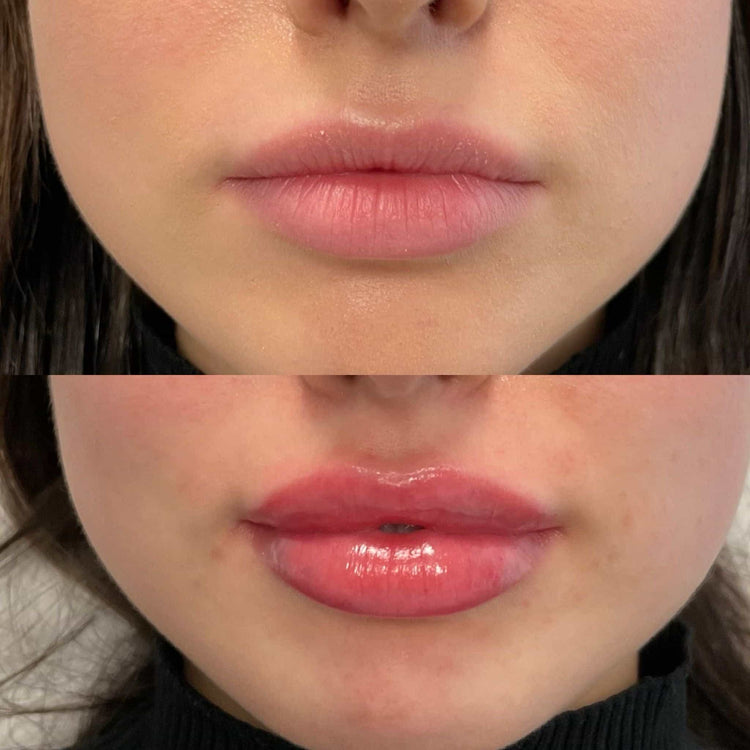Understanding Common Dermal Filler Complications
Dermal fillers have become increasingly popular for enhancing facial features and reducing wrinkles. While generally safe, like any medical procedure, there are potential complications that can arise. Understanding these common issues, ranging from swelling and bruising to migration and lumps, is crucial for both patients and practitioners. This article will delve into the various types of dermal filler complications and provide guidance on how to correct them safely and effectively.
Asymmetry
One common complication associated with dermal filler injections is asymmetry. This can occur when fillers are not evenly distributed, resulting in one side of the face appearing different from the other. Asymmetry can manifest in various ways, such as an uneven lift or shape change. Other potential complications include swelling, bruising, redness, and tenderness at the injection site. In rare cases, more serious complications like infection or allergic reactions can occur.
Lumps and Nodules
Lumps and nodules are a common complication that can arise from dermal filler injections. They typically form when the filler material becomes clumped together or is injected too deeply into the tissues. These lumps may feel hard or tender to the touch and can be visible under the skin.
Several factors can contribute to the formation of lumps and nodules, including using a thick filler type, improper injection technique, and individual variations in tissue response. It’s important to note that not all lumps are indicative of a problem; some may resolve on their own over time as the body absorbs the filler material.
Vascular Occlusion
Vascular occlusion is a serious complication that can occur during dermal filler injections. It involves the blockage of blood vessels, which can lead to tissue damage and necrosis (tissue death). This complication arises when filler material enters a blood vessel and obstructs blood flow to surrounding tissues.
- Vascular occlusion is most commonly associated with the use of certain types of fillers containing hyaluronic acid
- Injecting filler too deeply into the dermis or subcutis increases the risk of vascular occlusion
- Patients with pre-existing medical conditions, such as diabetes or blood clotting disorders, are at a higher risk
Allergic Reactions
Allergic reactions to dermal fillers are relatively rare but can be serious. They typically manifest within minutes to hours after the injection and may involve symptoms such as itching, hives, swelling of the face or throat, difficulty breathing, and in severe cases, anaphylaxis.
These reactions occur when the body’s immune system identifies the filler material as a foreign substance and mounts an inflammatory response. The severity of allergic reactions can vary widely from mild discomfort to life-threatening anaphylaxis. It is crucial for individuals considering dermal filler injections to discuss their medical history, including any allergies, with their practitioner beforehand.
Evaluating the Situation
Dermal fillers offer a non-surgical way to enhance facial features and rejuvenate skin, but potential complications can arise. Recognizing these issues early on is essential for safe and effective treatment.
Assessing Severity of Complications
Evaluating the situation accurately is paramount in addressing dermal filler complications. Healthcare professionals need to carefully assess the type of complication, its severity, and the patient’s medical history. This involves a thorough examination of the affected area, considering factors such as swelling, redness, pain, and any unusual lumps or changes in skin texture.
Determining the severity of complications is crucial for guiding treatment decisions. Mild complications like minor swelling or bruising may resolve on their own with time and simple home care measures. However, more serious issues such as vascular occlusion or allergic reactions require immediate medical attention. The practitioner will need to weigh the risks and benefits of various treatment options based on the individual patient’s circumstances.
Patient History and Medical Examination
A thorough patient history is essential for understanding potential contributing factors to dermal filler complications. This includes inquiring about any previous injections, medications being taken, allergies, medical conditions, and smoking habits.
A comprehensive medical examination allows healthcare professionals to visualize the affected area, assess the extent of swelling, redness, or tenderness, palpate for lumps or nodules, and evaluate the patient’s overall health status.
Diagnostic Imaging (if necessary)

When evaluating a potential dermal filler complication, it is crucial to determine the type, severity, and underlying cause. A thorough examination of the affected area is essential, paying attention to swelling, redness, pain, changes in skin texture, or the presence of lumps or nodules.
Diagnostic imaging, such as ultrasound or MRI, may be necessary in some cases to visualize the filler’s distribution and rule out complications like vascular occlusion or infection. Ultrasound is generally the preferred imaging modality for evaluating dermal fillers due to its non-invasive nature and ability to provide real-time imaging.
Corrective Measures
Dermal fillers have become increasingly popular, but it’s crucial to understand potential complications. These can range from mild issues like swelling and bruising to more serious concerns such as vascular occlusion or allergic reactions.
Dissolving Filler with Hyaluronidase
When dealing with dermal filler complications, dissolving the filler using hyaluronidase is a common and effective treatment. Hyaluronidase is an enzyme that breaks down hyaluronic acid, the main component of many popular dermal fillers.
Hyaluronidase is injected directly into the area where the filler has caused problems. It works by hydrolyzing the hyaluronic acid molecules, effectively breaking them down into smaller fragments that can be naturally absorbed by the body.
This process gradually dissolves the filler, reducing swelling, lumps, and other associated complications. The extent of correction depends on the type and amount of filler injected, as well as individual patient responses.
Manual Lumps and Nodules Breakdown
Corrective measures for dermal filler complications depend on the specific issue encountered. For lumps and nodules caused by filler clumping or deep injection, hyaluronidase, an enzyme that breaks down hyaluronic acid, can be injected into the area to dissolve the filler.
This process gradually reduces the size of the lumps and improves their appearance over time. Depending on the severity and location of the lumps, multiple hyaluronidase injections may be needed to achieve optimal results.
Other corrective measures might include massage techniques to disperse the filler or corticosteroid injections to reduce inflammation and swelling associated with lumps.

Vascular Occlusion Treatment
Vascular occlusion is a serious complication that requires immediate attention. Treatment typically involves administering hyaluronidase to dissolve the filler blocking blood flow. However, if tissue damage has already occurred, medical intervention may include medications to promote healing or in severe cases, surgical intervention to remove damaged tissue.
In cases of allergic reactions, prompt treatment is essential. Antihistamines and corticosteroids can be administered to alleviate symptoms such as itching, swelling, and hives. If anaphylaxis occurs, epinephrine (adrenaline) is administered immediately to counteract the life-threatening effects of this severe reaction.
Management of Allergic Reactions
Management of allergic reactions to dermal fillers necessitates prompt intervention. Antihistamines and corticosteroids are typically administered to mitigate symptoms like itching, swelling, and hives. In cases of anaphylaxis, epinephrine (adrenaline) should be given immediately to counter the life-threatening effects of this severe reaction.
Vascular occlusion, a serious complication arising from filler blockage of blood vessels, demands immediate attention. Treatment often involves administering hyaluronidase to dissolve the obstructing filler and restore blood flow. If tissue damage has occurred, medications to promote healing or, in severe cases, surgical intervention to remove damaged tissue may be necessary.
Corrective measures for dermal filler complications depend on the specific issue encountered. Hyaluronidase is commonly used to dissolve hyaluronic acid-based fillers causing lumps, nodules, or vascular occlusion.
Massage techniques may also be employed to disperse filler and alleviate lump formation. In some cases, corticosteroid injections can reduce inflammation and swelling associated with lumps.
Post-Treatment Care and Recovery
Post-treatment care is crucial for ensuring a successful outcome and minimizing the risk of complications following dermal filler injections. Patients should carefully follow their practitioner’s instructions regarding aftercare measures, which may include avoiding strenuous activities, applying cold compresses to reduce swelling, and keeping the treated area clean and moisturized.
Follow-up Appointments
Post-treatment care is crucial for ensuring a successful outcome and minimizing the risk of complications following dermal filler injections. Patients should carefully follow their practitioner’s instructions regarding aftercare measures, which may include avoiding strenuous activities, applying cold compresses to reduce swelling, and keeping the treated area clean and moisturized.
Follow-up appointments are essential for monitoring the healing process and addressing any potential complications that may arise. These appointments allow healthcare professionals to assess the results of the treatment, check for any signs of infection or other adverse reactions, and make any necessary adjustments.
Patients should report any unusual symptoms, such as persistent swelling, pain, redness, or changes in skin texture, to their practitioner immediately. Early detection and intervention can help prevent further complications and ensure optimal healing.
Recommendations for Minimizing Future Complications
Post-treatment care is crucial for ensuring a successful outcome and minimizing the risk of complications following dermal filler injections. Patients should carefully follow their practitioner’s instructions regarding aftercare measures, which may include avoiding strenuous activities, applying cold compresses to reduce swelling, and keeping the treated area clean and moisturized.
Follow-up appointments are essential for monitoring the healing process and addressing any potential complications that may arise. These appointments allow healthcare professionals to assess the results of the treatment, check for any signs of infection or other adverse reactions, and make any necessary adjustments.
Patients should report any unusual symptoms, such as persistent swelling, pain, redness, or changes in skin texture, to their practitioner immediately. Early detection and intervention can help prevent further complications and ensure optimal healing.
Minimizing future complications involves several key steps. Choosing a qualified and experienced practitioner who is well-versed in dermal filler techniques and safety protocols is paramount. Thoroughly discussing medical history, allergies, and any medications being taken with the practitioner before the procedure is essential for identifying potential risks and ensuring safe treatment.
Following post-treatment care instructions meticulously can help prevent complications such as infection or swelling. Avoiding sun exposure and protecting the treated area from excessive heat or cold is important to minimize inflammation and ensure proper healing.
Lastly, understanding the nature of dermal fillers and their limitations is crucial. While they can effectively enhance facial features, it’s important to have realistic expectations and understand that results are not permanent. Regular touch-up appointments may be necessary to maintain desired outcomes.
- The Best THC Beverages For A Relaxing Evening At Home - December 6, 2025
- The Benefits Of CBD Gummy Edibles For Overall Wellness - December 3, 2025
- THC Seltzers:A New Trend In Social Drinking - December 2, 2025
